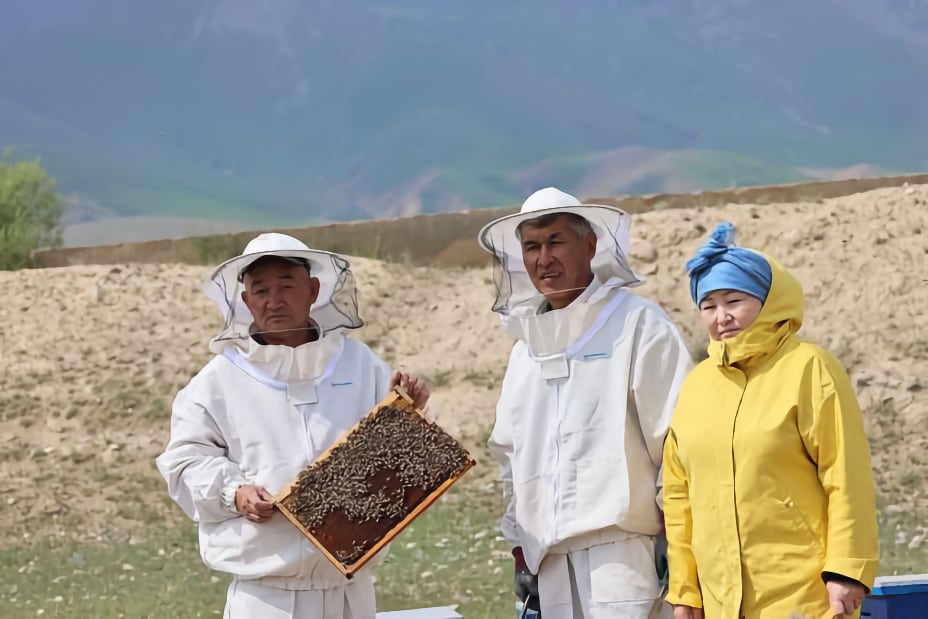Mention the North Pole or a species at risk due to climate change and people often think of polar bears. And thanks in part to the film March of the Penguins, the emperor penguin has become synonymous with the South Pole. But did you know our planet also has a Third Pole?
August 9, 2023
By Snow Leopard Trust

20% of snow leopard-friendly beekeeping profits in Kyrgyzstan fund conservation projects
Located in Asia’s high mountains, this Third Pole has the highest concentration of snow and glaciers outside the Arctic and Antarctic regions and is thought to store 7,000 trillion liters of the planet’s fresh water. It plays a major role in sequestering carbon and determines weather patterns across many countries. It is also home to the legendary ghost of the mountains.
The snow leopard, living just above the tree line and below the permanent glaciers, is custom-designed by evolution to survive in this steep terrain with thin air and extreme temperatures. This elusive cat roams 12 Asian countries with no passport or visa required to cross borders. Research confirms it crosses international boundaries regularly as long as they are not fenced, making it the ideal ambassador of the Third Pole, transboundary cooperation and climate impacts.
The Third Pole is home to 14 of the world’s highest peaks and 100,000 sq km of glaciers. This region is projected to be severely affected by climate change and is anticipated to warm at twice the average warming rate of the northern hemisphere. These changes will cause greater stress on human populations, especially the marginalized and vulnerable living in remote mountains dependent on limited resources. Extreme events are increasing in the form of flash floods, droughts and other disasters, which will cause significant losses to lives, livestock and livelihoods. Climate change will likely interact with every other threat snow leopards face, making each of them worse.

Glaciers are melting at an unprecedented rate. The increasing risk of emerging infectious diseases in the Third Pole due to warming and globalization threatens humans and snow leopards alike. New roads and infrastructure development in once inaccessible habitats facilitate the illegal wildlife trade. These threats not only affect snow leopards and other wildlife but also have a cascading impact on us, our well-being and our livelihoods.
Temperatures in snow leopard habitat are extreme, ranging from -40 to +40 degrees Celsius. While they may be able to withstand some level of warming, snow leopards will be affected by how humans respond. The lives of these elusive cats and the indigenous people of High Asia are as intertwined with glaciers and snow as they are with each other. Catastrophic weather events and forced changes in livelihood options could result in more human-wildlife interaction and, thus, lower acceptance of wildlife and negative encounters.
That’s why Snow Leopard Trust initiatives emphasizing climate adaptation programs are so vital. These include helping local and indigenous communities diversify their livelihood options, catalyzing better disease and healthcare management in people, livestock and wildlife, and strengthening peoples’ ability to coexist with snow leopards and other biodiversity.
Our most successful conservation programs are founded upon the PARTNERS Principles for community engagement. From beekeeping to eco-tourism to cheese and sustainable cashmere production, economic development that expands livelihood sources without damaging snow leopard habitat is an increasingly powerful tool for climate adaptation. These programs are designed to foster coexistence with snow leopards.
To ensure snow leopards roam these peaks for generations to come, we must prepare for a future when the snow melts. Our continuing research to better understand how this mountain-dwelling species will be affected by a warming climate is critical to developing solutions to protect it.
You can help by raising awareness about the importance of climate action to protect snow leopards and their unique habitat, known as the Third Pole.
Photo credits: Prasenjeet Yadav and our partner, Snow Leopard Foundation-Kyrgyzstan